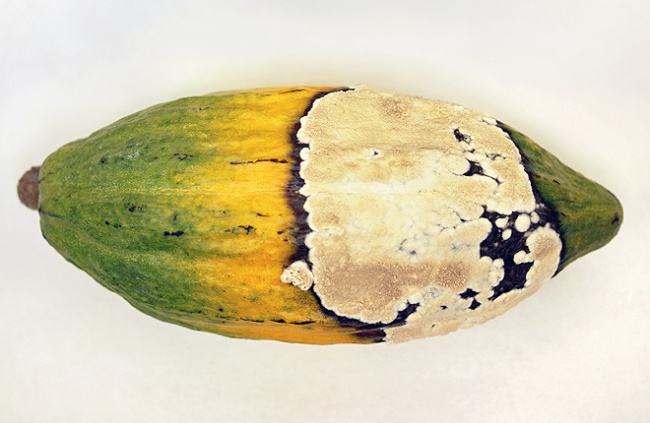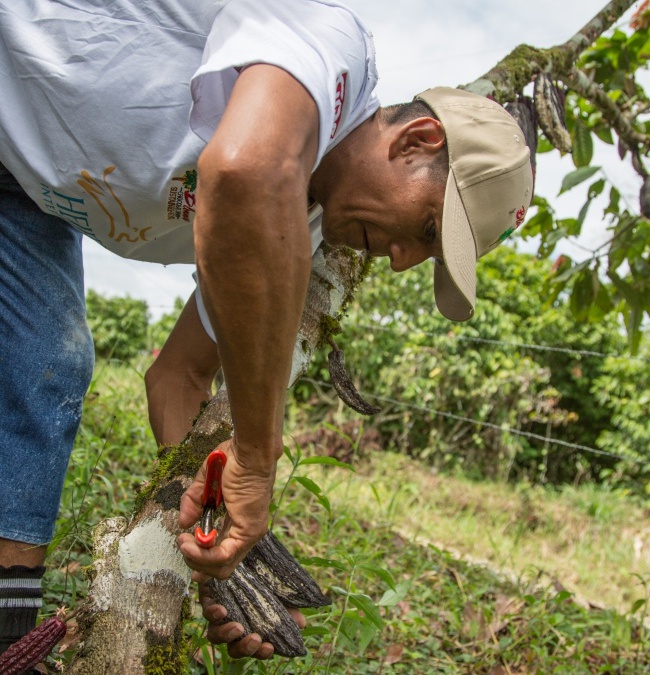Your Chocolate Might Have Survived This Fungus in Ecuador

A cut-open cocoa pod reveals the raw seeds inside.
Photo from Heifer International.
Since the late 1800s, a virulent fungus has been spreading across Ecuador’s cacao fields.
Formally known as Moniliophthora roreri—and colloquially called frosty pod rot or monilia—the fungus appeared in South America and devastated Ecuadorian and Columbian cacao plantations. It has prompted less-experienced farmers to abandon their fields, according to research by Bryan Bailey and Lyndel Meinhardt, plant pathologists at the USDA.
Frosty pod rot is a dangerous disease because it eats away at the cacao pods before symptoms become visible. The fungus also spreads easily through white, dust-like spores, said Leonardo Mendieta, cacao projects manager at Heifer International. It is believed to have originated in Ecuador and spread to all cacao-producing countries in the world in the 20th century.
Half of all cacao grown in Ecuador is ruined by frosty pod rot.
Although Ecuador produces only about 4 percent of the world’s supply of cacao, the country is renowned for producing beans that are used in expensive, high-quality chocolate, according to the European Campaign for Fair Chocolate. Half of all cacao grown in Ecuador is ruined by frosty pod rot, and the disease presents a significant financial risk to cacao farmers, exporters, and chocolate-makers who rely on healthy beans.
Rural farmer Jessica Granillo grew up drinking sweet chocolate milk made from her mother’s just-harvested cacao beans. She has continued the family business, running her own cacao plantation in Ecuador for the past seven years. But Granillo also has been battling frosty pod rot and loses income for every pod she has to chuck in the trash.

Cacao pod with symptoms of frosty pod rot. Photo by Shahin Ali via USDA.
Fortunately, farmers like her are being trained in how to manage, if not prevent, frosty pod rot. Organizations including Heifer International and the Belgian Development Agency, private cacao-exporting companies, and local farmers’ alliances have teamed up to provide a series of free classes called “Life and Cacao.” The courses cover total plant health, such as how to fertilize crops with organic techniques, with an emphasis on eliminating the fungus. Staff from the offices of local exporters, where the farmers sell their beans, teach the classes.
“If they don’t have support from organizations or a program, including government, this problem of disease could kill all the production [of cacao in Ecuador],” Mendieta said through a translator.
Worldwide demand for the high-quality beans incentivized sharing anti-fungal techniques.
Training happens at exporters’ offices when farmers drop off their regular crop of beans. Occasionally the classes take place in cacao fields for more hands-on experience.
Claro Blacio, sustainability director at Ecuadorian exporter EcoKakao, said he’s been working for a decade with programs that teach farmers how to manage diseases like frosty pod rot. Large corporations typically have been able to eradicate them with chemical fungicides, although even that method isn’t completely effective. Farmers who want to meet organic standards don’t even have that option. That’s where the specialized training comes in.
The moniliophthora fungus had been tolerated for generations, and many farmers expected losses as a matter of course. But growing worldwide demand for the high-quality beans has provided incentives for sharing anti-fungal techniques.
Even with help, farmers face an uphill battle. “It’s going to be almost impossible to remove the monilia out of the plantation, but you can change the numbers,” Blacio said. “More like 80 [percent] or 90 percent good plants and 10 percent bad plants. That’s a big goal.”
Research published in the The American Phytopathological Society’s journal found that, depending on the weather, age of the crop, and length of time the fungus is present on a site and other factors, frosty pod rot can account for up to 100 percent of the loss of any given cacao crop.
The farmers want to make sure their crops meet organic standards.
The most critical technique used to avoid the fungus is pruning leaves, because it allows more light to hit the tree, Mendieta said. Because the fungus will only grow in a cold, wet area, sunlight is a surprisingly easy fix. But it must be done skillfully or the farmer risks cutting off branches that could grow healthier pods. It’s also important to use fertilizer and chemical fungicides, but very selectively—the farmers still want to make sure their crops meet organic standards.
Pruning dry branches also is important, because otherwise they will retain moisture and promote the growth of fungi, farm inspector Manuel Ufredo Bravo Santana said in an email. Heifer trained him how to manage fields infected by the fungus, particularly through selective pruning, and now he’s teaching other Ecuadoran farmers those skills.

-
An Ecuadorian man removes cacao pods infected with monilia from a tree. Monilia or frosty pod rot is a fungus that destroys cacao pods and makes the beans inside inedible. Photo from Heifer International.
Bravo Santana, who manages his own crop of cacao, bananas, and papaya, teaches local farmers around Bolívar Province how to use a machete to remove branches from a tree without stressing it, because a stressed tree can quickly become a dead tree.
Santana said via email that fungus shouldn’t be an everyday sight on cacao trees. Until he took some classes, he didn’t realize “that [fungus] flowering is not normal.”
That’s part of the problem, Blacio said. Some farmers just expect frosty pod rot because it was there when their parents and grandparents farmed these fields, so they built a certain amount of loss into their yield estimates every year. But there’s hope that an increase in using new techniques to control the fungus will lead to a larger, healthier economy, he said.
Granillo has seen her crops improve from the anti-fungal techniques she’s learned. After using these techniques for a few years, she’s been able to push back the fungus. It still affects about 25 percent of her crops, however.
“Before, I made many mistakes,” she said. “Not now.”






